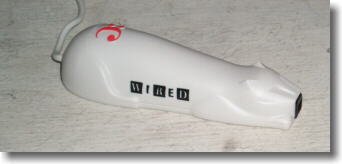Did you ever receive a peculiar little gadget in the mail, seemingly out of the blue? Back in the early 2000s, many Wired magazine subscribers did. It was a free “cat,” a device designed to scan barcodes, resembling a mouse but, as some noted, looking more like a small fox. This “cat,” known as the CueCat, was supposed to be a revolutionary tool, bridging the gap between print and the internet. But instead, it became a cautionary tale, a purr-fect example of a business idea fueled by excessive spending and ultimately, a spectacular flop – a true “Cat With Money” that vanished quickly.
 Image of the CueCat barcode scanner, a gadget that cost millions but failed to catch on
Image of the CueCat barcode scanner, a gadget that cost millions but failed to catch on
This “cat,” officially named :CueCat (yes, the colon was part of the name), was manufactured by DigitalConvergence.:Com. This company, boasting a surprising 200 employees, aimed to revolutionize advertising by making it easier for magazine readers to visit advertiser websites. The idea was simple: scan a barcode in a magazine ad with the CueCat, and your web browser would automatically navigate to the advertised website – perhaps the Altoids webpage, as the example suggested.
However, the sheer number of questionable decisions and the flawed business logic behind the CueCat were immediately apparent. The most glaring issue was the staggering amount of money being burned. With 200 employees, even at a conservative estimate, DigitalConvergence.:Com was likely spending millions each month on salaries alone. Mailing these free CueCats to Wired’s half-million subscribers, along with the cost of manufacturing the devices, software CDs, and cables, pushed expenses into the stratosphere. The company was hemorrhaging cash at an alarming rate, reminiscent of the infamous Iridium satellite phone project known for its massive financial losses.
The fundamental question was: who were the investors willing to pour so much “money” into this “cat”? Didn’t they realize the inherent flaws in the concept? Apparently not, or perhaps they were caught up in the dot-com bubble frenzy where extravagant spending was often mistaken for innovation. The reality was that the CueCat was fundamentally flawed for several key reasons:
1. A Solution in Search of a Problem
The core problem with the CueCat was its lack of utility for the average user. What problem did it actually solve? DigitalConvergence.:Com seemed to suggest two:
- Typing URLs is too difficult: This was a weak premise. Navigating to a website like Altoids.com, consisting of a mere seven characters, was hardly an insurmountable task. The minor inconvenience of typing a short URL hardly justified the need for a dedicated barcode scanner.
- Magazines struggle to prove ad effectiveness: This seemed to be the real motivation, aiming to provide advertisers with tangible metrics of ad engagement. However, this too was based on a flawed assumption – that people would actually use these “cats.” The reality was that sending out millions of free CueCats was incredibly expensive, and the vast majority were likely destined for the trash. Even if a small percentage of Wired subscribers installed the device, say 1%, resulting in 5,000 active users, the advertising metrics would be negligible. Impressing advertisers with a handful of scans per ad page was simply unrealistic.
Furthermore, the CueCat offered no inherent entertainment value or consumer benefit. The accompanying instructions, which included steps on “TO CHANGE YOUR COMPUTER’S BIOS SETTINGS…”, were hardly enticing. For consumers, there was simply no compelling reason to install and use the CueCat. No benefit meant no users, rendering the entire venture pointless.
2. Trapped in the Chicken and Egg Paradox
The CueCat suffered from the classic “chicken and egg” problem, a common pitfall for many technology initiatives.
- Advertisers wouldn’t use barcodes without users: No advertiser would bother incorporating CueCat barcodes into their ads if there wasn’t a significant user base. Adding barcodes was an extra step and looked unconventional.
- Users wouldn’t install CueCats without barcodes everywhere: Conversely, people wouldn’t install and use the CueCat if they rarely encountered barcodes in magazines or elsewhere. Why bother with a device that had limited real-world application?
DigitalConvergence.:Com attempted to circumvent this dilemma by massively distributing free CueCats. However, even mailing them to half a million Wired subscribers was a drop in the ocean compared to the hundreds of millions of internet users. The system also bizarrely allowed scanning UPC symbols from product packaging, enabling users to visit, for example, the Campbell’s Tomato Soup website by scanning the soup can itself. These efforts were ultimately futile, half-hearted attempts to overcome a fundamental flaw in the business model.
3. Forgotten as Quickly as Last Month’s Tech Fad
The CueCat wasn’t even Wired magazine’s first attempt at bridging print and web advertising. Just months prior, Wired promoted a different technology involving taking a digital photo of a page and using software to navigate to a website. This cumbersome process – involving digital cameras, memory cards, and software installation – was quickly abandoned. The fact that the CueCat replaced it so swiftly underscored the magazine’s desperate search for an effective solution, and perhaps a lack of critical evaluation of new, shiny tech ideas. The previous technology, much like the CueCat, became a fleeting memory, a “flash in the primordial soup” of dot-com era experiments.
Ultimately, the CueCat became a symbol of misplaced “money” and misguided business strategy. Companies that spend vast sums attempting to persuade people to adopt technologies with no clear benefit, and which are inherently flawed from the start, are unlikely to succeed. The CueCat’s fate was sealed.
[June 16, 2001: Digital Convergence lays off most employees.]